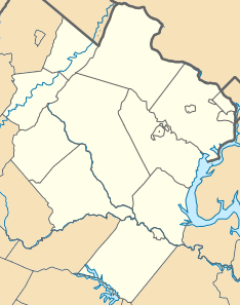Mason Neck, Virginia facts for kids
Quick facts for kids
Mason Neck, Virginia
|
|
|---|---|

Wetlands in Mason Neck State Park
|
|
| Country | United States |
| State | Virginia |
| County | Fairfax |
| Area | |
| • Total | 20.0 sq mi (51.9 km2) |
| • Land | 13.9 sq mi (35.9 km2) |
| • Water | 6.2 sq mi (16.0 km2) |
| Elevation | 20 ft (6 m) |
| Population
(2010)
|
|
| • Total | 2,005 |
| • Density | 145/sq mi (55.9/km2) |
| Time zone | UTC−5 (Eastern (EST)) |
| • Summer (DST) | UTC−4 (EDT) |
| FIPS code | 51-49998 |
| GNIS feature ID | 2584877 |
Mason Neck is a piece of land that sticks out into the Potomac River in Fairfax County, Virginia. It's located southwest of Washington, D.C.. This area is surrounded by water on three sides: Belmont Bay to the west, the Potomac River to the south and east, and Gunston Cove and Pohick Bay to the north. Mason Neck is the very southern part of Fairfax County in Northern Virginia. It covers about 51.8 square kilometers (20 square miles). A large part of this land, about two-thirds, is protected as parkland. In 2010, about 2,005 people lived in Mason Neck.
Contents
History of Mason Neck
Before European settlers arrived, the Doeg tribe lived on the Mason Neck peninsula. The recorded history of Mason Neck began around 1755. This is when Gunston Hall was built. It was the large home of George Mason. He was an important person who helped write the Virginia Declaration of Rights. Mason Neck is also home to Pohick Church. Both George Mason and George Washington attended this church. Another historic building is Cranford Methodist Church, built in 1857. It was used as a hospital during the American Civil War.
In the 1800s and early 1900s, much of the land was used for cutting down trees. This included large pine and hardwood trees. Over time, pollution and losing natural homes for animals caused the number of bald eagles to drop. By the 1960s, many of the forests had grown back. However, new homes being built for people moving from Washington, D.C., became a new threat. In 1969, local people and groups who wanted to protect nature worked together. They helped create the Elizabeth Hartwell Mason Neck National Wildlife Refuge. Its main goal was to protect the bald eagle. Along with this refuge, Mason Neck State Park and Pohick Bay Regional Park offer fun outdoor activities. They also help keep the land's natural beauty safe.
Amazing Wildlife
Mason Neck is a wonderful home for many different animals and plants. Besides bald eagles, you can find over 211 types of birds here. There are also more than 200 kinds of plants. Over 31 types of mammals and 40 types of reptiles and amphibians live here too.
Birds of Mason Neck
You might see large great blue herons, Canada geese, and ospreys. Other birds include wood ducks, teal, different kinds of owls, and woodpeckers.
Mammals of Mason Neck
Whitetail deer are very common. You can also find beavers, muskrats, groundhogs, and foxes.
Reptiles and Amphibians
On warm summer nights, you can hear many types of frogs and toads. Different kinds of turtles live around ponds, streams, and wet areas. These include Eastern box turtles, eastern snapping turtles, wood turtles, and spotted turtles. You might also see snakes, such as the northern copperhead and the northern black racer.
See also

- In Spanish: Península Mason Neck para niños




